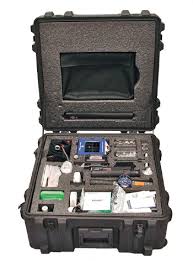Setting up a fiber optic connection involves more than simply splicing cables together. One of the most critical steps in the process is ensuring that fiber terminations are clean, precise, and secure. A proper termination process allows the light signals traveling through the fiber to transfer efficiently from one cable to another or into equipment without loss or interference. To achieve this, technicians rely on a specialized set of tools known as a fiber termination kit. These kits are designed to streamline the termination process while ensuring consistency, precision, and durability in the connections.
Whether you’re a seasoned fiber technician or just entering the field of fiber optics, understanding the components of a termination kit—and how to use them effectively—can make a significant difference in both the performance of the network and the time it takes to complete the job.
What Comes in a Fiber Termination Kit?
A fiber termination kit typically includes a combination of specialized tools and consumable supplies intended for the accurate handling and secure termination of fiber optic cables. While the exact tools may vary depending on the manufacturer or type of fiber being used, most standard kits contain the following essentials:
-
Fiber Cleaver: This tool ensures a clean, perpendicular cut at the end of the fiber. A high-quality cleave is essential for proper light transmission and minimizes signal loss.
-
Stripping Tool: Designed to carefully strip the protective outer jacket and coating from the fiber without damaging the delicate glass core beneath. Accurate stripping is critical for proper connector alignment.
-
Kevlar Scissors: Fiber optic cables are often reinforced with Kevlar fibers (aramid yarn) for strength. These specialized scissors are used to cut these strong materials without dulling the blades.
-
Crimping Tool: Once the fiber is inserted into a connector, the crimping tool secures it in place, creating a reliable mechanical connection.
-
Connector Holders or Alignment Fixtures: These tools hold connectors steady during termination, ensuring that the fiber aligns correctly inside the connector.
-
Cleaning Supplies: Cleanliness is paramount in fiber optics. Kits often include alcohol wipes, lint-free cloths, and swabs to clean fiber ends before and after termination, helping to prevent dust or oil contamination that can degrade performance.
-
Curing Oven or Heater (for epoxy-style connectors): If you’re using connectors that require epoxy adhesive, a small curing oven is used to harden the glue and secure the fiber in place.
Advanced kits may also contain visual fault locators (VFLs), inspection microscopes, or optical power meters for testing and verification, making them more suitable for professional and commercial-grade installations.
Why Proper Termination Matters
Fiber optic cables carry data in the form of light pulses, so any imperfection at the connector interface—such as dirt, poor cleaving, or misalignment—can cause serious signal loss or back reflection. This is why precision tools and a proper termination process are essential. Even a tiny speck of dust can prevent proper data transmission, leading to network slowdowns or failures.
By using a complete termination kit and following a methodical process, technicians can ensure that each fiber end is prepared and connected to deliver high-speed, high-bandwidth performance reliably.
Safety Tips When Working With Fiber Optics
While fiber optics may seem safer than copper wiring (no electrical current is involved), working with ultra-thin strands of glass introduces its own set of hazards. Here are a few safety best practices to follow:
-
Always wear safety glasses: When cleaving or cutting fiber, tiny shards of glass may be released. These can be dangerous if they get into your eyes.
-
Dispose of waste properly: Fiber scraps are sharp and nearly invisible. Use a sealed, marked container to dispose of them safely and prevent accidental injuries.
-
Avoid skin and eye contact: Don’t touch your eyes or face while working with fiber strands, especially when using epoxy or chemicals.
-
Work in a well-ventilated area: Some adhesives used in the termination process emit fumes that can be irritating or harmful if inhaled.
Following these basic precautions ensures that you remain safe while maintaining a clean and controlled workspace.
When to Replace Kit Tools
Even the highest-quality tools will degrade over time with repeated use. Knowing when to replace specific components in your kit is vital to maintaining termination quality:
-
Dull cleaver blades: If your cleaver isn’t producing clean, flat fiber ends, the blade may be dull and should be replaced. A poor cleave leads to weak connections and higher insertion loss.
-
Worn-out strippers: A good stripping tool should remove the coating cleanly. If it starts scratching the glass or pulling unevenly, it’s time for a replacement.
-
Old cleaning supplies: Alcohol wipes and swabs lose effectiveness over time. Regularly check and replenish your stock to ensure proper fiber cleanliness before termination.
Regular tool maintenance and timely replacements not only improve efficiency but also enhance the performance of your fiber optic network.
Final Thoughts
A fiber termination kit is more than a convenience—it’s a necessity for building fast, reliable, and long-lasting fiber optic connections. Whether you’re installing fiber in a residential setting, a data center, or a large commercial environment, using the right tools ensures that every termination meets industry standards.
With practice, patience, and an eye for detail, anyone can become proficient at fiber termination. A well-prepared kit, combined with proper technique and adherence to safety practices, allows you to deliver consistent results and minimize costly rework. As fiber networks continue to expand across homes and businesses worldwide, mastering the use of your termination kit will remain a valuable and in-demand skill.






